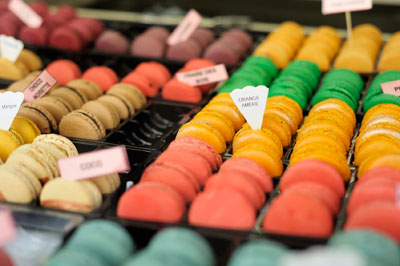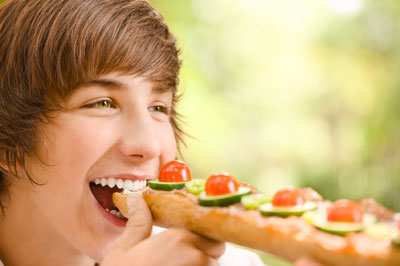
Training your taste
February 29, 2012
By
Laura Aiken
Taste is really tops for your customers.
Taste is really tops for your customers. There’s little point in disputing that. While factors like providing lower fat and sodium options are driving product innovation, the real winning goods are still the ones that make you go “mmmmmm.”
 |
|
| Strong colours suggest rich flavour.
|
We’re going to explore the science of our special sense of taste and give you a few tips for how to fine-tune your buds for your own recipe development.
What is taste?
Food is first consumed by sight, confirms sensory analysis expert John Hale while presenting at Puratos’ 2011 Toronto International Bakery Symposium (tibs). Lisa Duizer, assistant professor and graduate co-ordinator in the department of food science at the University of Guelph, seconds that absolutely.
“Colour has a big impact if it’s unusual,” says Duizer. “I was at a conference in another country and it was the fourth of July. I wasn’t in the U.S. but to honour their American guests they served bread dyed red, white and blue. Nobody ate it. When the colour is not what you expect you tend to regard it quite suspiciously.”
One need look no farther than the resounding failure of coloured ketchup to see how important it is for things to look as we expect. A darker red colour is associated with stronger flavour (up to a point, no neon), says Duizer. So if you want to portray a vibrant taste, ensure your hues are bold and rich.
Hale, who is the director of product appraisal and customer care for Sobeys, listed the full category of taste as being sweet, salt, butter, unami, sour and the often-overlooked metallic. Unami is the taste of MSG. When you eat, you pick up these flavours, as well as smells and mouth feel. Food heats up as you chew and our taste buds pick up the taste compounds, explains Duizer. When you swallow, it creates a vacuum that pulls those compounds into the olfactory nerves in the back of the brain. This is where our connection with smell and taste happens.
“I hear a lot of people say they have a cold and can’t taste,” she says. “But you can. Your ability to smell is impaired but you can still taste.”
Hale shared some other interesting misconceptions and facts about taste at his tibs talk. Smoking doesn’t actually wreck your ability to taste, as is popularly thought. Rather, he says, nicotine enhances the taste of sweetness but destroys bitterness. What can actually ruin your sense of taste is too many chillis. We get hooked on the endorphins and the accompanying rush when we eat spicy food but they can burn out your taste buds. And that tradition of coffee after dinner? Hale says coffee is a real culprit, interfering with the taste of that gourmet meal if you drink it before or after. Hale’s field of sensory analysis is rather sophisticated, and the backbone of food processor consumer testing. Sensory analysis means using human senses to determine differences, preferences, and quality grading. The U.S. army caterers founded modern sensory analysis using a nine-point hedonic scale, which was further advanced by Rose Marie Pangborn, but Hale says it’s essentially still the best one. Sensory analysis is on a rather sophisticated path. Advances in the works include being able to see brain activity, using new methodology with time and intensity and preference mapping so they can make a product that matches what the consumer wants exactly and links with emotion. Sensory analysis is what gives you the balance of quality versus cost, he says.
Tips for better taste-testing
Yes, you can improve your taste buds. The more experience you have tasting, the more aware you’ll be, says Duizer. Start by honing your awareness of taste nuances. The University of Guelph works with a lot of bread tasting, so when teaching people to evaluate the product they start by teaching them the differences in levels of one aspect. For instance, to evaluate the sweetness of the bread, they give them varying sugar solutions so they start to understand what is sweet and what is not. This method helps your ability to assign a taste, like sweetness, to a scale.
 |
|
| The foods we are exposed to growing up play a role in determining the foods we enjoy as adults.
|
Duizer suggests going out and getting some herbs, perhaps starting with one kind such as basil. Buy this herb in all its forms – dried, fresh, Thai, etc. You want to start with an understanding of the ingredient in all its different forms before incorporating it into the dish. This is a good way to determine how you want the flavour of the finished product to be.
Be aware that while food will taste different to a smoker than it does to a non-smoker, it is still individual, she says. However, it helps to leave some space between the cigarette and the tasting of your latest creation.
When teaching yourself to taste, blind is a better way to be impartial. If you were trying to compare your muffins to the competition, do it blind so you get a true measure.
Don’t do tastings in a room with lots of odours; you’ll get all those other smells in the food. Don’t taste in the kitchen; instead, take it out to the dining room or another area where it’s more neutral.
If you have multiple versions of a recipe side by side, don’t eat too much of each when tasting to determine which ought to be your winner. You get fatigued very quickly, says Duizer. A small portion is better than a whole slice. She also noted that people often confuse bitter and sour, so if that’s the taste you’re trying to detect, be aware that it’s a toughie.
Social eaters
Taste is complex beyond the science. Its emotional and deeply rooted in what we’ve been exposed to.
“Exposure is the way to improve liking,” says Duizer. She adds that what we eat in our adolescence is the most important for the development of the range of things we like to eat. In essence, the broadening tastes of the changing face of Canada are due in part to our repeated sampling of new flavours.
Ethnicity really makes a difference in tasting, notes Hale. Preferences are cultural and rooted in what you’re brought up with.
What people choose to consume is also dictated by factors beyond taste buds. Duizer recalls a recent conference where they discussed how findings that showed changing environment altered what people choose to drink. For example, in a pub-like atmosphere they were more inclined to order than in a slick, modern martini-inducing room.
Taste is a complex and fascinating subject worth studying. Keep your senses finely tuned for great results in the kitchen.
Print this page
Leave a Reply